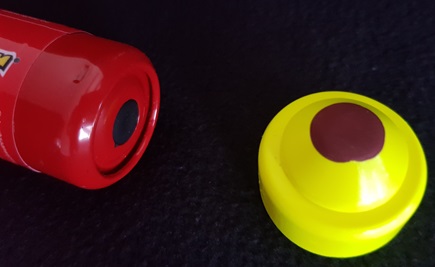HOW THE SPITA FIREFIGHTER WORKS
The SPITA FireFighter is a manual, portable fire extinguisher with a remarkable extinguishing capacity and works with a potassium powder jet
– a unique method among fire extinguishers – which involves the vaporization of the powder in the environment followed by the condensation of its extinguishing substance.
The potassium reacts directly to the oxygen present at a fire. As a result, the fire does not receive enough oxygen (the "catalyst" of the fire) and will therefore diminish and eventually get extinguished.
 Yellow cap for
the ignition
plastic handle metal tube with
extinguishing charge
The device is a small, compact, lightweight cylinder:
- the upper part of the device is a metal tube containing
the extinguishing charge.
- the lower part of the device is composed of plastic and
serves as a support handle.
The SPITA FireFighter is composed of stable, solid potassium minerals, contains no gas and is NOT PRESSURIZED.

The aerosol-like extinguishing jet
is only produced when the igniter
(brown point on yellow cap)
is rubbed over the base (dark dot
on red metal tube).
The produced aerosol jet is
essentially an inert salt that
emits gas already present in the atmosphere. This process allows the SPITA FireFighter to extinguish all types
of fires Class A, B, C, E and F through saturation.
How the extinguishing proces of the SPITA FireFighter works:
The extinguishing process involves two different reactions, a physical and a chemical reaction. The physical reaction relates to potassium’s tendency to oxidize rapidly in air. When in contact with air, potassium molecules consume great quantities of oxygen, thus depriving fires of oxygen. The chemical reaction is created through a stable link between potassium particles and the fire’s combustion particles. Through the two reactions, a quick oxidation process takes place, immediately transforming the jet from a solid state into a gaseous state which frees the potassium particles. These particles are able to intercept and interrupt any other free particles produced by the fire’s chain reaction combustion process.
Potassium has strong inhibitor qualities, due to its weak ionization energies.
Its slow biodegradation in the environment furthers the prevention of subsequent fires.
The entire process is more environmentally friendly than using extinguishing foam or powder.
Also the remains are easier to remove after the fire is extinguished
|